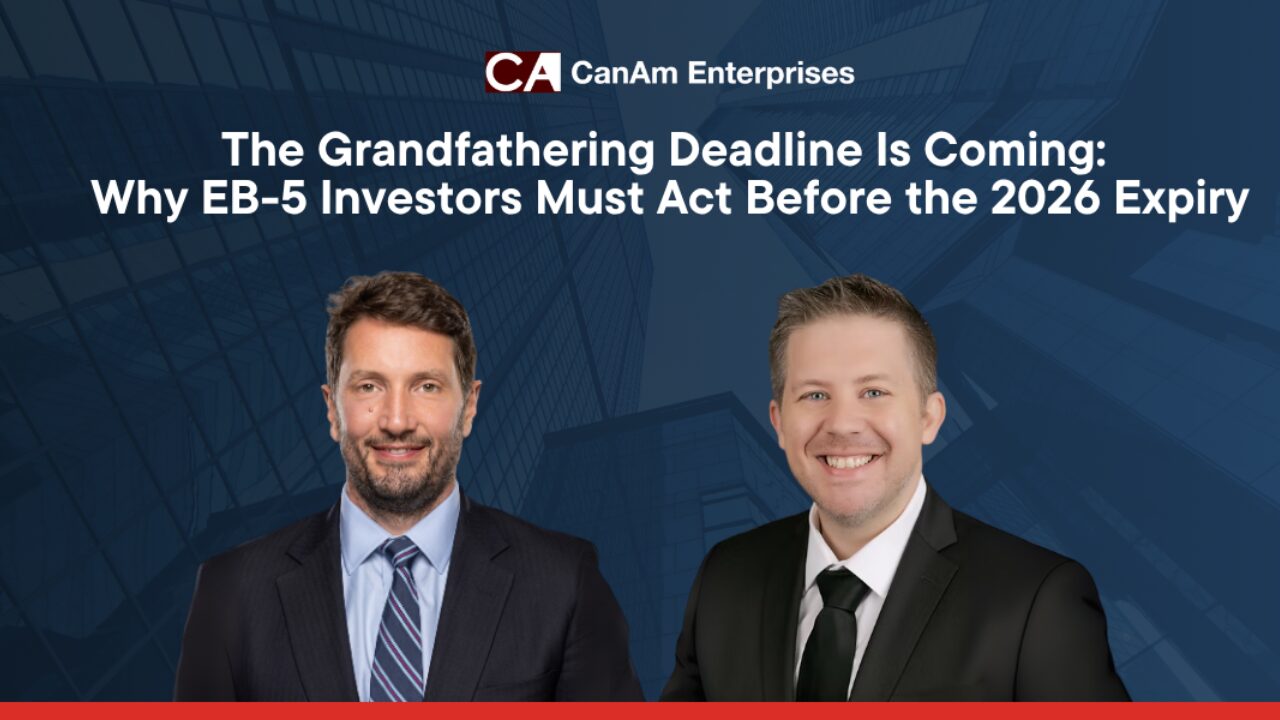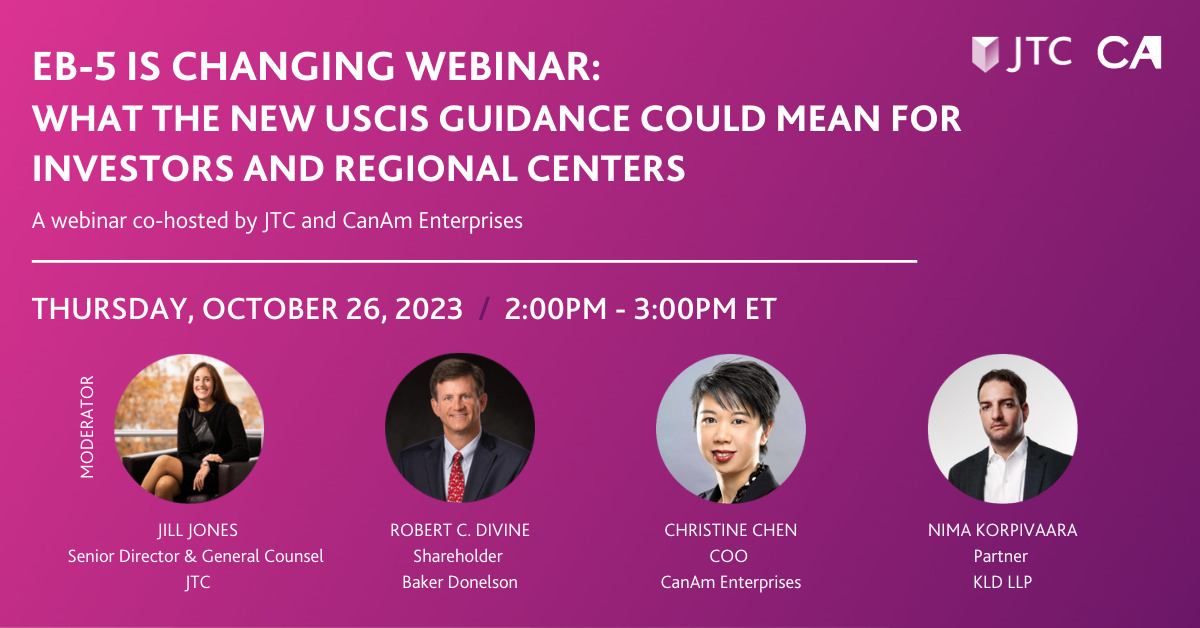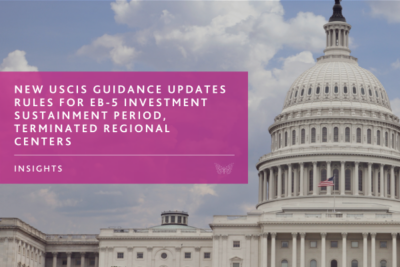Financial Strategies for EB-5 Success
For EB-5 investors, securing a green card is only the beginning. The real challenge lies in preparing for the complex financial realities of life in the United States—taxation, banking, insurance, estate planning, and asset protection. Without a proactive strategy, even the most financially sophisticated investors can face costly surprises.
In a recent webinar hosted by CanAm Enterprises, CEO, Pete Calabrese sat down with Paul Fegan and Jason Auerbach, Managing Directors at Navis Wealth Management, to explore what it takes to build long-term financial stability as a new U.S. resident. Together, they delivered a powerful message: plan early, stay flexible, and surround yourself with advisors who understand the cross-border landscape. Here’s what prospective and current EB-5 investors need to know.
The Tax Clock Starts Ticking—Fast
Many EB-5 investors underestimate how quickly U.S. tax obligations kick in. As soon as you receive conditional permanent residency, you become subject to U.S. tax on your worldwide income. That includes salaries, pensions, rental income, dividends, and even gains from real estate or investment portfolios held overseas.
“Even a small $20,000 pension from your home country must be declared on your U.S. tax return,” said Fegan. “The mistake people make is assuming that if money isn’t physically moved to the U.S., it’s not taxed here. That’s simply not true.”
Investors also need to be aware of U.S. tax treaties that could reduce or eliminate double taxation—but only if claimed properly. Failing to file the right forms often results in paying more than necessary.
The message is clear: before filing your I-526E petition, speak to a cross-border tax advisor. Understanding how U.S. taxation applies to your current financial picture can prevent future penalties and maximize your post-move net income.
The Hidden Dangers of Overseas Funds
One of the most common (and painful) tax traps for new U.S. residents is owning non-U.S. mutual funds or ETFs. These are typically classified as Passive Foreign Investment Companies (PFICs) under U.S. tax law—triggering extremely punitive tax treatment.
“A vanilla S&P 500 ETF bought abroad can wipe out half its value in U.S. penalties if you omit the PFIC filings,” warned Auerbach. “And the IRS doesn’t care that you didn’t know.”
The solution? Reposition your investment portfolio before becoming a resident alien. Strategies include:
- Transferring assets to a U.S. brokerage account.
- Recreating index exposure using individual securities instead of pooled funds.
- Working with U.S.-compliant offshore funds (though these often require very high minimum investments).
Failing to address PFIC exposure can result in years of interest charges and headaches with the IRS. As Auerbach noted, “This is an area where planning even three months early can save hundreds of thousands of dollars.”
Cross-Border Business Holdings Require Special Care
Many EB-5 investors are business owners, holding interests in operating companies or real estate ventures abroad. U.S. tax law includes provisions like “Subpart F,” which can impute income to the investor—even when no cash has been received—if they own a large enough share in a foreign corporation.
Fegan recommends taking a proactive approach. “Sometimes inserting a ‘blocker’ entity can shield that income from immediate U.S. taxation and preserve more control over distributions.” He emphasized that structure matters—and that any changes should be made well before the investor becomes a U.S. tax resident.
Banking Challenges in a New Country
Moving money across borders is rarely as simple as it seems. Once you become a U.S. green card holder, many foreign banks become hesitant—or outright unwilling—to maintain your accounts. In one case shared during the webinar, a client was given just 30 days to close long-standing bank accounts in Asia.
“Banks are increasingly cautious about U.S. compliance obligations,” explained Auerbach. “They don’t want the exposure if they have more than 99 U.S. clients and have to report under FATCA.”
That means investors need to secure both foreign and U.S. banking relationships early in their transition. A checklist includes:
- Gathering verifiable source-of-wealth documentation.
- Opening a U.S. bank account that supports international wires and dual-currency needs.
- Starting to build U.S. credit through compatible debit and credit cards.
Being cut off from your own funds is a disruption no one wants to experience during an international move.
Insurance and Asset Protection: Gaps You May Not Expect
The U.S. insurance market operates very differently from those in many other countries. Life and disability insurance, for instance, can be hard to obtain for new residents, especially those without immediate income or credit history.
“Only a handful of U.S. carriers will even look at non-citizen applicants,” said Auerbach. That makes it essential to plan early if you want meaningful life or income protection in place after arrival.
Equally important is structuring real estate and other assets to limit liability. Many foreign investors are unfamiliar with U.S.-style limited liability companies (LLCs) or umbrella insurance policies, both of which are frequently used to protect high-value property from lawsuits.
Estate Planning: Avoiding Unintended Tax Consequences
Estate planning is another area where U.S. and foreign rules diverge sharply. One major misconception: that a green card holder can transfer assets to a spouse tax-free, just as U.S. citizens can.
“That’s not true,” said Fegan. “If one spouse passes away, the survivor may owe U.S. estate tax immediately unless a Qualified Domestic Trust (QDOT) is in place.”
The webinar outlined several critical estate planning actions:
- Align wills across jurisdictions or draft a single, worldwide estate plan.
- Be aware of how different states treat non-citizen residents for estate-tax purposes.
- Consider gift strategies before becoming a U.S. resident—especially if assets are being transferred to children or other family members abroad.
A thoughtful estate plan doesn’t just protect your heirs—it ensures your financial legacy reflects your intentions, not legal loopholes.
Building Your U.S. Financial Team
“Moving to the U.S. is like arriving in a city where you don’t speak the language,” said Calabrese. “You need a local guide—and probably more than one.”
The panel emphasized assembling a cross-disciplinary team of professionals who understand both your home country and the U.S. system. This includes:
- A cross-border tax advisor or CPA
- A U.S.-based wealth manager familiar with foreign asset issues
- An estate planning attorney with international experience
- A private banker or U.S. credit expert
- An insurance advisor with access to non-resident policies
“Your team becomes your advocate,” said Fegan. “They can spot the problems you don’t even know exist yet.”
Your First-Year Action Plan
To help EB-5 investors put all this advice into action, the speakers offered a suggested timeline for key steps:
Before Filing I-526E
- Inventory global assets and income
- Evaluate investment holdings for PFIC exposure
- Consult a cross-border tax advisor
3–6 Months Pre-Move
- Open U.S. bank and brokerage accounts
- Draft or update your estate plan
- Start transitioning foreign companies or real estate holdings
First 6 Months in U.S.
- Build credit history
- Purchase U.S.-compliant insurance
- File your first U.S. tax return with FBAR and related disclosures
Year 1–2
- Review investment strategy
- Update trust or LLC structures as needed
- Begin naturalization planning, if desired
Final Thoughts: Preparation Is Protection
The overarching message from the CanAm × Navis webinar was simple but powerful: Transparency fuels effective planning, and early action protects long-term wealth.
“There’s no one-size-fits-all blueprint,” said Fegan. “But every successful transition starts with an honest conversation—about your goals, your assets, and your family’s future.”
Whether you’re just beginning your EB-5 journey or already preparing to move to the U.S., the time to engage advisors and develop your strategy is now. With the right guidance and a well-executed plan, your investment in an EB-5 visa can be the gateway not just to a green card—but to lasting financial peace of mind.
Related Articles:
- EB-5 and Indo-US Tax Law with Grant Thornton
- Gold as a Strategic Asset: Strengthening Your Investment Portfolio
- Navigating Opportunity: What the Current U.S. Economy Means for Immigrant Investors







